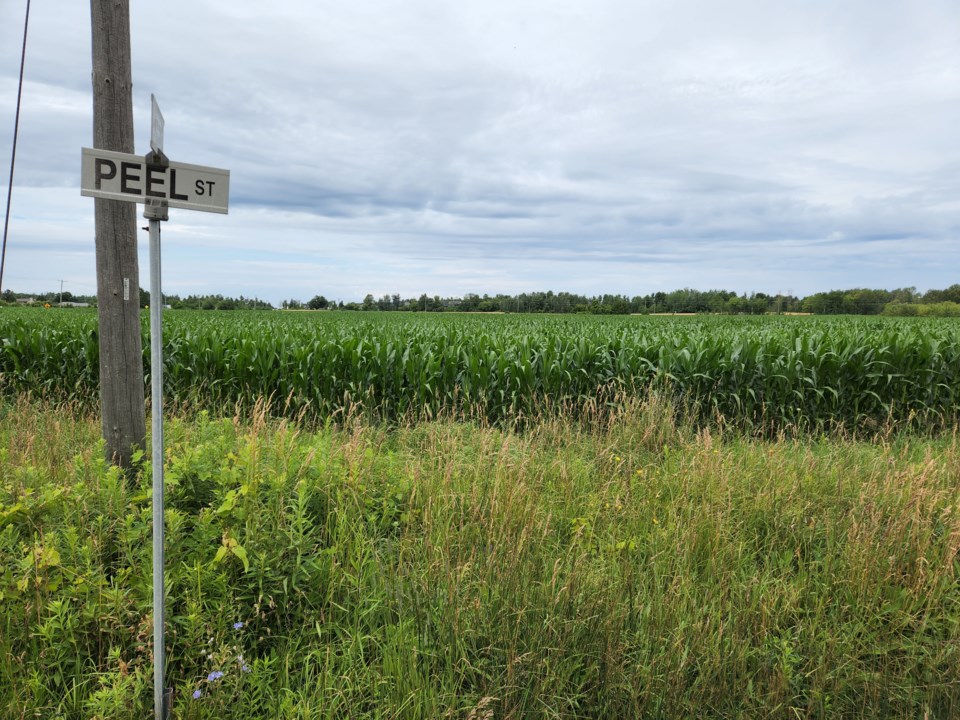The servicing of the Campus of Care lands is going to be one big and expensive project for the town.
On March 7, the Town of The Blue Mountains held a public information session about options for servicing the 125 Peel Street property where the Campus of Care is going to be located.
The property, which is currently in a more rural area of the town just outside of Thornbury, will be the home of a long-term care centre, affordable/attainable housing development, a daycare, as well as parkland, green space and trails. Part of the property is also being left open for future uses, which could include a recreational complex.
The public meeting was an opportunity for members of the community to see a number of different servicing options for the property, plus potential upgrades/changes to three local roads – Baring, Peel and Alice streets – depending on the servicing option chosen by the town.
“We recognize this project has significant impacts. This area is going to change,” said project consultant Jamie Witherspoon, noting that the project essentially entails the conversion of a rural area of Thornbury into a more urbanized area.
The meeting detailed the potential options the town could pursue, but did not include any forecasted costs in the presentation. The project design hasn’t advanced far enough for costs to be projected at this time.
Servicing options include:
- Campus of Care only, watermain replacement on Alice and Baring streets. This is the low-cost option, but future servicing needs/upgrades/expansions would require rebuilding of relatively new roads.
- Service Campus of Care and extend servicing to neighbouring properties including existing watermain replacement on Alice, Peel and Baring streets. This is the mid-cost option, but does address all properties in the area.
- Service Campus of Care and extend servicing for all current and future properties along the project alignment including water and sanitary sewers. This is the highest-cost option and would see full servicing for the entire area installed now.
A choice the town faces is whether to limit the project to getting services strictly to the Campus of Care site or expanding the project to a much larger scale that would include the installation of services capable of handling future development in that area of town that is expected in the coming years.
Upgrades to local roads in that area are contingent on what direction for servicing the town chooses to pursue. Road options include: leaving the roads largely rural (with upgrades to underground infrastructure), full urbanization of the roads, streets becoming one way or partial closures of certain roads. Full details of the options for the various streets can be found on the project webpage here.
As part of the project, consultants have completed a transportation study, have looked at active transportation needs in the area and have completed a study of trees and vegetation in the area.
The virtual meeting was viewed by about 30 local residents and questions focused on what recreation trails would look like in the area when the project is complete, how much the Campus of Care development would be paying for servicing and costs local residents would face.
Tom Maloney questioned why 10th Line – with no existing residences – was not being used to service the Campus of Care property.
“You’re imposing an amazing impact on this neighbourhood,” said Maloney. “This is so disruptive, costly and unnecessary.”
In response, Witherspoon said using Peel Street is the most “direct route” for servicing and noted that there are no sanitary sewers on 10th Line.
Another local resident said she felt “sick to her stomach” knowing that massive change was coming to the neighbourhood with the servicing project.
No decisions on the project have been made yet. The next step is a follow-up report to council including comments and concerns raised at the PIC. The project will then proceed to the 70 - 90 per cent design phase, followed by a second PIC and follow up report.
Tenders for the project are expected to be issued in the fall of 2024, with construction starting the following spring.



